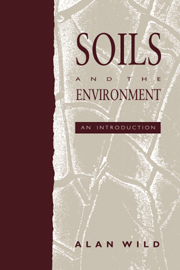Book contents
- Frontmatter
- Contents
- Preface
- Acknowledgements
- Units, symbols and general information
- 1 Introduction: soil in a natural and man-made environment
- A Soil properties and processes
- B Soils in relation to the environment
- 7 Soil as a medium for plant growth
- 8 Soil conditions and crop production
- 9 Soil acidification
- 10 Heavy metals and radionuclides in soil
- 11 Soils, the atmosphere, global warming and ozone depletion
- 12 Soil erosion and conservation
- 13 Soils in the environment: problems and solutions
- Suggestions for further reading
- Index
13 - Soils in the environment: problems and solutions
Published online by Cambridge University Press: 06 January 2010
- Frontmatter
- Contents
- Preface
- Acknowledgements
- Units, symbols and general information
- 1 Introduction: soil in a natural and man-made environment
- A Soil properties and processes
- B Soils in relation to the environment
- 7 Soil as a medium for plant growth
- 8 Soil conditions and crop production
- 9 Soil acidification
- 10 Heavy metals and radionuclides in soil
- 11 Soils, the atmosphere, global warming and ozone depletion
- 12 Soil erosion and conservation
- 13 Soils in the environment: problems and solutions
- Suggestions for further reading
- Index
Summary
Introduction
Soils are needed to grow crops for food, animal fodder and fibre, trees for fuel and timber, and to support natural woodlands and grasslands. As the human population has increased new land has been brought into cultivation. This trend has ended in many parts of the world where all that remains is land that is either too difficult or uneconomic to cultivate. Conservation of natural ecosystems, the importance of which is being increasingly accepted, further restricts the expansion of agriculture.
Prediction of the growth of the human population is that between 1991 and 2001 the population will have risen from 5.4 billion to 6.4 billion and will have reached 10 billion some time in the second half of the twenty-first century. Much of this increase will be in the Third World. One requirement will be to manage soils so as to provide this increased population with food and with wood for fuel. This raises the question whether more intensive systems of management can be employed which, at the same time, are sustainable in environments where soils are fragile, the rains are unreliable or erosive, and the essential requirements for development are sparse.
There are different problems in countries elsewhere, especially in Europe and North America. Overproduction of food provides some justification for less intensive farming systems, with land being taken out of cultivation, for example by the set-aside scheme in the UK and the soil bank in the USA. Overproduction has led to criticism of the use of fertilizers and pesticides, and the advocacy of less intensive systems such as organic farming.
- Type
- Chapter
- Information
- Soils and the Environment , pp. 249 - 276Publisher: Cambridge University PressPrint publication year: 1993



